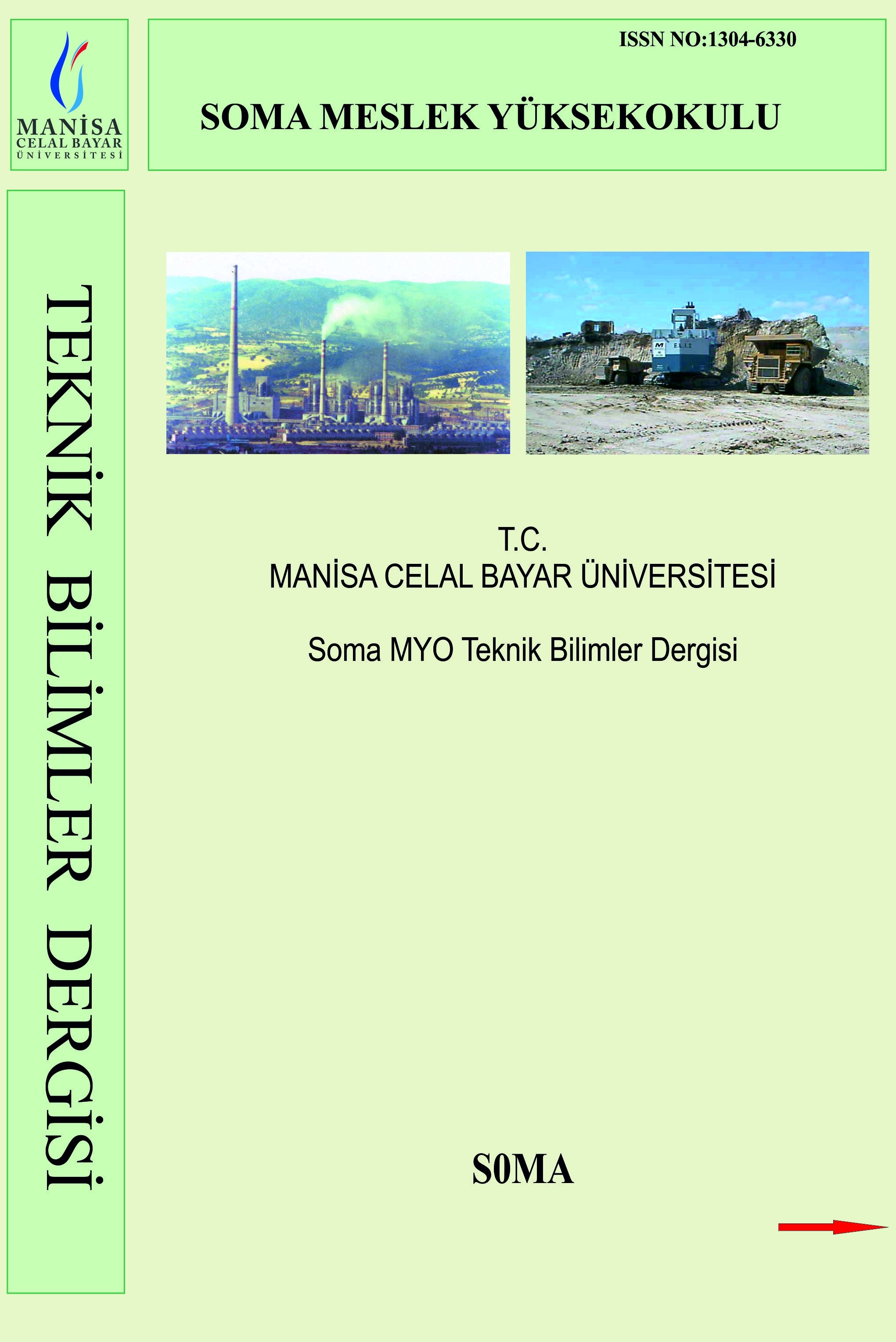KARAHAYIT (DENİZLİ) YERLEŞİM ALANINDAKİ AÇILMA ÇATLAKLARININ İNCELENMESİ VE TEKTONİK - PALEOSİSMOLOJİK YORUMLAMASI
Fay, Çatlak, Karahayıt, Tektonik açılma, Traverten, Yapısal hasar
INVESTİGATİON OF TENSİONAL FİSSURES İN KARAHAYIT (DENİZLİ) SETTLEMENT AREA AND THEİR TECTONİCAL - PALEOSEİSMOLOGİCAL İNTERPRETATİON
Fault, Crack, Karahayıt, Tectonical opening, Travertine, Structural damage,
___
- 1-Alçiçek, H. 2006. Denizli Neojen havzası’nın sedimanter fasiyesleri, depolanma ortamları ve paleocoğrafik gelişimi, GB Anadolu, Turkiye. 59. Türkiye Jeoloji Kurultayı Bildiri Özetleri. Altunel, E. Ve Barka, A., 1996, Hierapolis’deki arkeosismik hasarların değerlendirilmesi, TJK Bülteni, 39/2, 65-74
- 2-Altunel, E., 1996. Pamukkale Travertenlerinin Morfolojik Özellikleri, Yaşlari ve Neotektonik Önemleri. MTA Dergisi, 118: 47–64 Altunel, E., Hancock, P.L., 1993. Morphology and structural setting of Quaternary travertines at Pamukkale, Turkey. Geol. J. 28, 335–346.
- 3-Ambraseys, N.N. & Finkel, C. 1995, The Seismicity of Turkey and Adjacent Areas. A Historical Review 1500–1800. Eren Yayıncılık, Istanbul.
- 4-Brogi, A., Capezzuoli, E., Alçiçek, M.C. and Gandin, A., 2014, Evolution of a fault controlled fissure-ridge type travertine deposit in the western Anatolia extensional province: the Çukurbağ fissure-ridge (Pamukkale, Turkey), Journal of Geological Society, 171, 425-441
- 5-Çakır, Z., 1999, Along-Strike Discontinuity of Active Normal Faults and Its Influence on Quaternary Travertine Deposition, Examples from Western Turkey. Tr. J. of Earth Sciences, 8: 67–80
- 6-Demirtaş, R., Erkmen, C. ve Yaman, M. 2000. Denizli ve yakın civarında deprem üreten diri faylar ve Gökpınar Sulama Barajı’nın depremsellik açısından irdelenmesi. Afet İşleri Genel Müdürlüğü Deprem Araştırma Dairesi Web Sitesi, http://sismo.deprem.gov.tr, Rapor No:011, Erişim Tarihi: 10.12.2005
- 7-Emre, Ö., Duman, T. Y., Özalp, S., Elmacı 2011, 1:250.000 Ölçekli Türkiye Diri Fay Haritası Serisi, Denizli (NJ 35-12) Paftası, Seri No:12, MadenTetkik veArama Genel Müdürlüğü, Ankara-Türkiye
- 8-Eravcı, B., Yaman, M., Tepeuğur, E., Erkmen, C., Aktan, T.,Albayrak, H. Ve Demirtaş, R., 2007, Batı Anadolu Çöküntü Bölgesinin Paleosismoloji Projesi, Afet İşl. Gen. Md. DAD, Rapor no 5691/1 (DPT2002 K 120050)
- 9-Görkem Mühendislik, 2008, Denizli Merkez Karahayıt İmar Planına Esas Jeolojik Jeoteknik Etüd Raporu (yayınlanmamış)
- 10-Hancock, P. L. and Altunel, E., 1997, Faulted Archeological Relics at Hierapolis (Pamukkale), Turkey, Goedynamics, 24, ¼, 21-36
- 11-Hancock, P.L., Chalmers, R.M.L., Altunel, E., Çakır, Z., 1999. Travitonics: using travertines in active fault studies. J. Struct. Geol. 21, 903–916.
- 12-Hançer, M., 2013, Study of the Structural Evolution of the Babadağ-Honaz and Pamukkale Fault Zones and the Related Earthquake Risk Potential of the Buldan Region in SW Anatolia, East of the Mediterranean, Journal of Earth Science (ISI) , 24/3, 397-409 pp.,
- 13-Koçyiğit, A. 2005. The Denizli graben-horst system and the eastern limit of western Anatolian continental extension: basin fill,structure,deformational mode,throw amount and episodic evolutionary history,SW Turkey. Geodinamica Acta 18/3-4,167-208.
- 14-Okay, A.İ. 1989, Denizli’nin güneyinde Menderes Masifi ve Likya Napları’nın jeolojisi, MTA Bul., 109, 45-58 (in Turkish with and English abstract).
- 15-Piccardi, L., 2008, The AD 60 Denizli Basin Earthquake and the Apparition of Archangel Michael at Colossae (Aegean Turkey). Geological Society, Special Publications, 273: 95–105, doi:10.1144/GSL.SP.2007.273.01.08
- 16-Rodríguez-Pascua, M. A., Calvo, J. P., De Vicente, G., and Gómez-Gras, D. 2000. Soft-sediment Deformation Structures Interpreted as Sismit in Lacustrine Sediments of the Prebetic Zone, SE Spain, and Their Potential use as Indicators of Earthquake Magnitudes During the Late Miocene, Sedimentary Geology (135)1-4, pp. 117-135.
- 17-Westaway, R. 1993. Neogene evolution of the Denizli region of Western Turkey. Journal of Structural Geology, 15, 37-53.
- 18-(www. sayisalgrafik.com) 19-(www.iris.edu) (yerbilimleri.mta.gov.tr) MTA Yerbilimleri Harita görüntüleyici MTA 1/500 000 ölçekli jeoloji-tektonik haritası
- ISSN: 1304-6330
- Başlangıç: 2004
- Yayıncı: Celal Bayar Üniversitesi
TEK SERBESTLİK DERECELİ ROBOT İLE BALANCE MASTER TEST CİHAZINDA DENGE VE PERFORMANS ÖLÇÜMÜ
Tolga OLCAY, Ata ELVAN, Cihan DAYANGAÇ, Ahmet ÖZKURT, İbrahim Engin ŞİMŞEK
AKYAKA (MUĞLA) VE YAKIN DOLAYINDAKİ FAYLARIN DEPREMSELLİK BAKIMINDAN İNCELENMESİ
KABLO TERMİNAL ÇIKARMA APARATLARININ İLERİ TEKNOLOJİLER İLE YERLİ ÜRETİMİ
İsmet ÇELİK, Bünyamin KAYA, Çağatay ÜSTÜNDAĞ
ISI EŞANJÖRÜ ISIL TASARIM METODOLOJİSİNİN TEMELLERİ
SOĞUK HADDELENMİŞ TİCARİ ALÜMİNYUM LEVHALARIN YORULMA DAYANIMLARININ YAPAY SİNİR AĞLARI İLE TAHMİNİ
Raif SAKİN, Ayla TEKİN, Nurcan KUMRU
AA2024 ALÜMİNYUM ALAŞIMINDA BİLYELİ DÖVME İŞLEMİNİN TANE BOYUTUNA ETKİSİ
Zehra ALKAN, Remzi VAROL, Ramazan SELVER
FENOLİK BİLEŞİKLERİN ENKAPSÜLASYONU
Eylem ATAK, Esma YILDIZ, Mehmet Emin USLU
